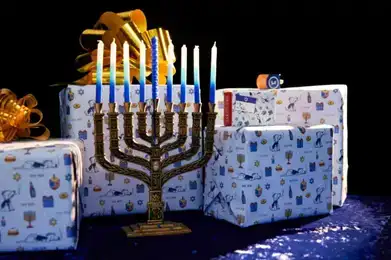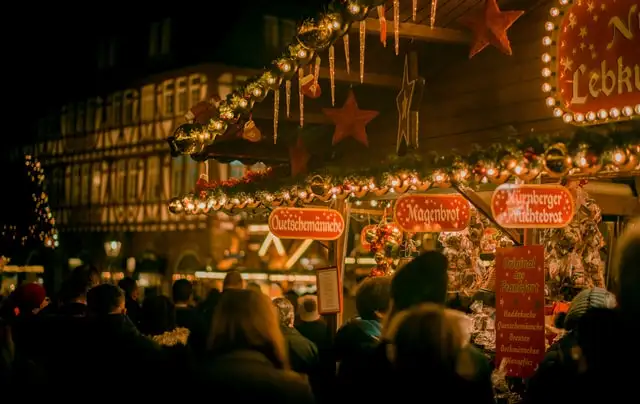While December may have the shortest day of the year or bone-chilling winter weather, it is also the most festive and joyous season in all 12 months. People and cultures worldwide have much to celebrate, commemorate and appreciate during this month in the dead of winter. December global holidays may be observed for various reasons, but all are the local calendar's most anticipated social and religious events.
So, here’s a brief guide to what to expect, the symbolisms, specialty foods, and how to celebrate some of the world’s most iconic December global holidays.
Hanukkah
Region: Israel and Jewish communities worldwide
Cultural Background: Religious / Judaism
Why: Commemorating the re-dedication of the Second Temple in Jerusalem

Hanukkah is a major December global holidays for the Jewish faith
Hanukkah, also known as the Festive of Lights, is an 8-day Jewish festival that begins on the Hebrew calendar's 25th day of the month of Kislev. That means each year, the exact days of Hanukkah vary according to the Gregorian calendar, but mostly it runs between late November and late December every year. This Jewish December global holidays commemorates the rededication of the Second Temple of Jerusalem.
Celebrated by Jewish communities around the world, traditional customs and practices include lighting the Menorah (a nine-branched candelabra) for eight nights, playing dreidel, giving gifts, celebrating with Hanukkah music. And of course, no good December global holidays is complete without eating delicious foods, for Hanukkah it’s fried potato latkes and jelly donuts (sufganiyot).
Krampusnacht
Region: Germany and parts of Europe
Cultural Background: Religious / Christianity
Why: Krampus comes out to scare naughty children in the weeks leading up to Christmas.
This December global holidays falls on December 5. Every year across Germany and other European countries, Krampusnacht or Krampus Night is celebrated with screaming kids and men dressed in scary devilish costumes. More like Halloween than Christmas, Krampusnacht is a centuries-old Christmas tradition that falls the night before the celebration of the Feast of St. Nicholas.

Krampus - Source: Alessio Zaccaria/Unsplash
Krampus is believed to be a half-man and half-goat creature with large horns, red eyes, and fangs. Men dressed in Krampus’s furry costume and demonic masks will visit each village to chase and swat naughty children with twigs each year. The meaning of this December global holidays is to remind children to behave themselves throughout the year, or Krampus will return the following year to punish them.
Santa Lucia
Region: Scandinavia and Italy
Cultural Background: Religious / Christianity
Why: A feast day celebrating Saint Lucy of Syracuse

Boys and girls dressed in white for concerts and processions
Santa Lucia is a special regional December global holiday that falls on December 13th. Important in Scandinavian countries like Sweden and Italy, this day commemorates Santa Lucia, an Italian Saint who died as a martyr. Her sacrifice is seen as a light figure in the year's darkest part.
A December global holidays that symbols light and hope, this day is celebrated by concerts and processions; Boys and girls dressed in white wearing headdresses with flickering candles; Coffee and baked goods (e.g., saffron bread and ginger biscuits) are eaten; And people will share small gifts with other members of the community like neighbors, bus drivers, and postman.
Winter Solstice and Yule
Region: Worldwide / Germany communities around the world
Cultural Background: Pagan
Why: Marking the shortest day in the Northern Hemisphere and moment in midwinter.

Burning a Yule log is a way to celebrate the Yuletide
For many cultures around the globe, the winter solstice or December solstice is not only the shortest day of the year but a special December global holidays of great significance and spiritual practice. In the Northern Hemisphere, it usually falls on the 21st or 22nd of December.
Traditions from around the world to mark this December global holidays include the Stonehenge gathering in the UK – druids, pagans, and ordinary people gather at the ancient stone circle for celebrations; Dongzhi, China – for thousands of years, Chinese people have marked this day with family get-togethers and a big meal including rice balls; and Shab-e Yalda, Iran – people celebrate this ancient Persian festive with family gatherings, candles, poetry readings, and a feast.

Rice balls - Source: shiyun/Unsplash
Yule or Yuletide is another December global holidays that falls within the Winter Solstice (December 21 – January 1). One of the oldest and most popular winter celebrations worldwide, it is an exceptional period, particularly for Germanic people worldwide. Some customary ways to celebrate Yuletide include building a Yule altar, creating an evergreen Yule wreath, burning a Yule log, and decorating a Yule tree (unlike Christmas trees, Yule trees are outdoor living trees that are decorated with hanging candles).
Christmas
Region: Worldwide
Cultural Background: Religious / Christianity
Why: Celebration of the birth of Jesus Christ

Christmas is a sacred religious holiday for Christians
Christmas falls on December 25th, one of the world's most important December global holidays. And it is a major celebration in the Christian calendar. The day marks the birth of Jesus Christ of Nazareth, whom Christians believe to be the last true prophet sent by God to save humanity. For many, Christmas is a series of religious events, like attending Church services on Christmas day. But it is celebrated for non-religious reasons too, such as decorating trees, social get-togethers, presents, and the Christmas feast.

Source: Rodion Kutsaev/Unsplash
Delicious food consumed during this December global holidays is an unmissable element of the festive celebration. Though most people think of roast turkey and Christmas pudding, the special culinary delights from different countries can be as varied as their customs. For example, roast lamb is the preferred meat of choice in Spain, not turkey or ham; Christmas Eve dinner for Polish families starts with the sharing of Oplatek wafers; The typical Christmas dessert in Germany is gingerbread (Lebkuchen), not Christmas pudding which is a favorite in the UK; And in Italy, soup is considered a festive food and many dishes don’t carry meat, due to the religious traditions in the country.

Source: Jed Owen/Unsplash
As Christmas is celebrated in many countries, how peoples and cultures mark this day take on unique twists. Here are some fascinating local traditions and practices of Christmas Day festivities around the world.
Germany: Nothing is more Christmassy than a lively Christmas Market where locals gather, drink mulled wine, shop for gifts, and indulge in seasonal gourmet foods. While these markets happen all over Europe, they are truly an age-old tradition in Germany, with many markets originating as far back as the 15th and 16th centuries.

Source: cmophoto.net/Unsplash
Japan: Christmas is a relatively new holiday in Japan, and thanks to a clever market campaign, local people find themselves ordering KFC for Christmas dinner, with orders placed with the restaurant months in advance.
Ireland: The Christmas celebrations in Ireland last from Christmas Eve until January 6th (Epiphany). On December 26th, children go from door to door singing while holding a stick topped with a holly bush and a wren, then they’d ask for money for the so-called starving wren.
Iceland: In the 13 days leading up to Christmas, 13, not 1, Santa Clauses called Yule Lads visit the children on each of the 13 nights leading up to Christmas. Each evening, children place their shoes by the window, and a different Yule Lad will leave gifts for the nice kids and rotting potatoes for the naughty ones.

Source: aiden patrissi/Unsplash
It is worth noting that, while most people think of Christmas Day as December 25th, for some 260 million orthodox Christians, they mark the birth of Christ on January 7th in line with the Julian calendar. According to Orthodox Christmas traditions and customs, Christians in countries like Egypt, Ethiopia, Russia, Serbia, and Macedonia experience a less commercialized Christmas than the rest of the world. On Orthodox Christmas Day, not a December global holiday, people typically go to church, exchange gifts, and eat a big feast of local specialty dishes.
Boxing Day
Region: Great Britain and some Commonwealth countries
Cultural Background: A secular holiday
Why: Originally a holiday to give gifts to the poor

Today Boxing Day is known as a shopping holiday
Boxing day is a December global holidays that falls on December 26th, the day after Christmas Day. For people in the United Kingdom and some Commonwealth countries like Australia, New Zealand, and Canada, this day is traditionally when gifts (and tips) are given to servants, tradespeople, and the poor. The origin of the name varies, some believe the box refers to the boxes of donations placed in churches for the poor. Others think they are the boxes of gifts given to employees the day after Christmas. Boxing Day also coincides with St. Stephen’s Day. As the patron saint of horses, it is common to see sporting events like horse races, rugby, and foxhunting on December 26th.
Boxing Day is a public holiday in numerous countries that observe it. In recent years, it has become a much-anticipated shopping day when post-Christmas sales draw big crowds looking for bargains.
Kwanzaa
Region: USA
Cultural Background: Cultural / African descendants of all faiths
Why: To celebrate and preserve African American history and culture

Kwanzaa was created by Dr. Maulana Karenga in 1966
Kwanzaa is a relatively new festival in the December global holidays, and it was created by Dr. Maulana Karenga in 1966 in the USA. This seven-day holiday starting on December 26th aims to celebrate family, culture, and heritage. Modeled after the first harvest celebrations in Africa, Dr. Karenga wanted an alternative to traditional Christmas festivities and something significant to the African American community to celebrate its own rich history and cultural practices.
The name Kwanzaa comes from a Swahili phrase meaning "first fruits." It draws on the symbolism and customs found in West and Southeast African harvest festivals. During the holiday period, people can recite African poetry and songs, play traditional African instruments, or gather for a large meal. The lighting of seven candles is also significant as it represents Kwanzaa’s seven guiding principles.
New Year’s Eve
Region: Worldwide
Cultural Background: Cultural celebration
Why: Marking the final day in the Gregorian calendar

Fireworks display is a popular way to celebrate New Year’s Eve
As December 31st is the last day of the year, according to the Gregorian calendar. People celebrate this December global holidays to mark the end of the old year and to welcome the start of the incoming year. It is both a religious and a secular holiday observed by visiting places of worship for a blessing, watching mesmerizing firework displays, or partying the night away with friends and loved ones in pubs and social gatherings.
Also known as Old Year's Day or Saint Sylvester's Day, New Year’s Eve traditions worldwide are similar yet full of local characteristics. Here are some regional holiday traditions of the December 31st festivities.

Source: Artem Kniaz/Unsplash
Japan: Families gather on Ōmisoka (New Year’s Eve) for one last meal of the old year with a bowl of toshikoshi-soba or udon. The eating of the long noodle symbolizes the crossing from one year to the next.
USA: While formal parties and big fireworks displays are common on New Year’s Eve, millions of Americans also stay up to watch the Times Square Ball Drop at the stroke of midnight on TV.
Brazil: It’s summer on New Year’s Eve, so locals rush to the beach after midnight, dressed in all white to symbolize purity, and then jump seven waves while making seven wishes. This tradition is rooted in paying homage to the goddess of water, Yemanja.
Denmark: Local tradition has it that throwing old plates at someone’s home will bring them good luck in the coming year. In fact, the more broken dishes at the doorstep, the better off the next year will be.
Philippines: Families will prepare 12 round fruits, like grapes and plums, on New Year’s Eve, hoping for good fortune next year. Locals believe these round fruits represent prosperity because of their shape, and 12 fruits represent each year's month.

Numerous December global holidays are marked by fireworks
In addition to the more iconic December global holidays mentioned above, there are numerous unique holidays and festivals celebrated by local cultures each December.
December 6 – Finland (Independence Day), Spain (Constitution Day)
December 8 – Bodhi Day (Day of Enlightenment in Buddhism)
December 10 – Human Rights Day, Thailand (Constitution Day)
December 12 – Mexico (The Day of the Virgin of Guadalupe)
December 16 – Bangladesh (Victory Day), South Africa (Day of Reconciliation)
